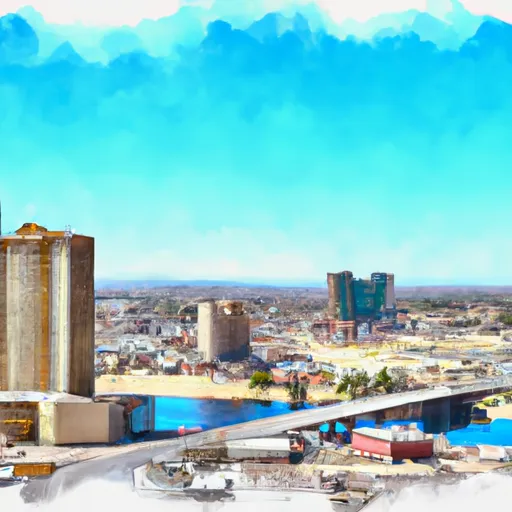-
 Snoflo Premium
Snoflo Premium
Get unlimited access to all our content
With no Ad interruptions! - Start Your Free Trial Login with existing account
Laughlin-A-F-B
Eden Index
Climate
7.1
•
Recreation
5.5
•
Community
2.0
•
Safeguard
5.3/10

Laughlin Air Force Base (AFB) is located in Del Rio, Texas. The climate in Laughlin AFB is characterized as a hot semi-arid climate, with long, hot summers and mild winters. Summers are typically scorching, with temperatures often exceeding 100°F, while winters are mild with temperatures ranging between 40°F to 70°F.
Hydrologically, Laughlin AFB sits near the Amistad Reservoir, located just a few miles northwest of the base. This reservoir is formed by the Rio Grande River and provides opportunities for various outdoor activities such as boating, fishing, and water skiing. The reservoir is known for its diverse fish population, including largemouth bass, catfish, and crappie.
Aside from water activities, Laughlin AFB offers a range of outdoor recreation opportunities. The base has well-maintained parks, picnic areas, and sports fields where families can enjoy outdoor activities such as soccer, baseball, and hiking. The nearby Val Verde Winery is also a popular attraction, offering wine tasting and tours.
In summary, Laughlin AFB experiences a hot semi-arid climate, has access to the Amistad Reservoir for water-based activities, and offers various outdoor recreation opportunities including sports, hiking, and wine tasting.
What is the Eden Index?
The Snoflo Eden Index serves as a comprehensive rating system for regions, evaluating their desirability through a holistic assessment of climate health, outdoor recreation opportunities, and natural disaster risk, acknowledging the profound impact of these factors on livability and well-being.
Climate Health Indicator (CHI): 7.1
Laughlin-A-F-B receives approximately
452mm of rain per year,
with humidity levels near 83%
and air temperatures averaging around
21°C.
Laughlin-A-F-B has a plant hardyness factor of
9, meaning
plants and agriculture in this region tend to thrive here all year round.
By considering the ideal temperature range, reliable water supplies, clean air, and stable seasonal rain or snowpacks, the Climate Health Indicator (CHI) underscores the significance of a healthy climate as the foundation for quality living.
A healthy climate is paramount for ensuring a high quality of life and livability in a region, fostering both physical well-being and environmental harmony. This can be characterized by ideal temperatures, reliable access to water supplies, clean air, and consistent seasonal rain or snowpacks.
Weather Forecast
Streamflow Conditions
Rio Grande-Falcon
Area Rivers
Rio Grande-Falcon
Snowpack Depths
Rio Grande-Falcon
Reservoir Storage Capacity
Rio Grande-Falcon
Groundwater Levels
Recreational Opportunity Index (ROI): 5.5
The Recreational Opportunity Index (ROI) recognizes the value of outdoor recreational options, such as parks, hiking trails, camping sites, and fishing spots, while acknowledging that climate plays a pivotal role in ensuring the comfort and consistency of these experiences.
Access to outdoor recreational opportunities, encompassing activities such as parks, hiking, camping, and fishing, is crucial for overall well-being, and the climate plays a pivotal role in enabling and enhancing these experiences, ensuring that individuals can engage in nature-based activities comfortably and consistently.
Camping Areas
| Campground | Campsites | Reservations | Toilets | Showers | Elevation |
|---|---|---|---|---|---|
| Rough Canyon - Amistad National Rec Area | 4 | 1,182 ft | |||
| San Pedro - Amistad National Rec Area | 35 | 1,131 ft | |||
| Southwinds Marina Lake Amistad Military | None | 1,140 ft | |||
| Governors Landing - Amistad National Rec Area | 15 | 1,139 ft | |||
| Laughlin AFB Military | None | 1,071 ft | |||
| 277 North - Amistad National Rec Area | 17 | 1,126 ft | |||
| Spur 406 - Amistad National Rec Area | 8 | 1,122 ft |
Nearby Fishing
Nearby Ski Areas
Catastrophe Safeguard Index (CSI):
The Catastrophe Safeguard Index (CSI) recognizes that natural disaster risk, encompassing floods, fires, hurricanes, and tornadoes, can drastically affect safety and the overall appeal of an area.
The level of natural disaster risk in a region significantly affects safety and the overall livability, with climate change amplifying these risks by potentially increasing the frequency and intensity of events like floods, fires, hurricanes, and tornadoes, thereby posing substantial challenges to community resilience and well-being.
Community Resilience Indicator (CRI): 2.0
The Community Resilience Indicator (CRI) recognizes that education, healthcare, and socioeconomics are crucial to the well-being of a region. The CRI acknowledges the profound impact of these elements on residents' overall quality of life. By evaluating educational resources, healthcare accessibility, and economic inclusivity, the index captures the essential aspects that contribute to a thriving community, fostering resident satisfaction, equity, and social cohesion.

